英语 人类的故事 从宇宙到地球
想象作文外星人来到地球上600英语
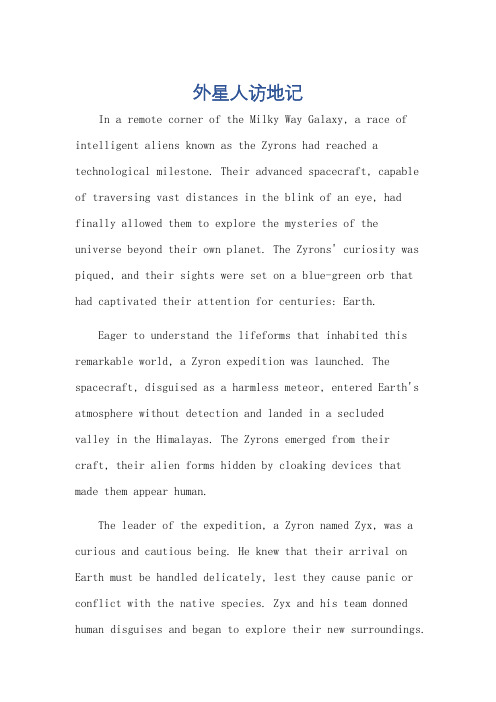
外星人访地记In a remote corner of the Milky Way Galaxy, a race of intelligent aliens known as the Zyrons had reached a technological milestone. Their advanced spacecraft, capable of traversing vast distances in the blink of an eye, had finally allowed them to explore the mysteries of the universe beyond their own planet. The Zyrons' curiosity was piqued, and their sights were set on a blue-green orb that had captivated their attention for centuries: Earth.Eager to understand the lifeforms that inhabited this remarkable world, a Zyron expedition was launched. The spacecraft, disguised as a harmless meteor, entered Earth's atmosphere without detection and landed in a secludedvalley in the Himalayas. The Zyrons emerged from their craft, their alien forms hidden by cloaking devices that made them appear human.The leader of the expedition, a Zyron named Zyx, was a curious and cautious being. He knew that their arrival on Earth must be handled delicately, lest they cause panic or conflict with the native species. Zyx and his team donned human disguises and began to explore their new surroundings.At first, the Zyrons were astounded by the natural beauty of Earth. The lush forests, the majestic mountains, and the vast oceans were all new and exciting to them. But what truly fascinated them was the life they encountered. The Zyrons observed humans interacting with each other, creating art, building cities, and exploring the vastness of their world.However, they also witnessed the darker side of human nature. They saw conflict and destruction, pollution and waste. This was a side of Earth that they had not anticipated, and it left them feeling conflicted. Zyx knew that their presence on Earth could not be solely for exploration. They must also help in some way, to offset the harm that they saw.So, the Zyrons began to share their advanced technology with the humans. They taught them clean energy methods that eliminated pollution, and they provided medical technologies that cured diseases that had plagued humanity for centuries. In return, the humans were fascinated by the Zyrons' knowledge and wisdom, and they welcomed them with open arms.As the days turned into weeks, and the weeks into months, the Zyrons' stay on Earth became more permanent. They built a small community in the Himalayas, where they lived harmoniously with the humans, sharing their knowledge and learning from theirs. Zyx even formed a friendship with a human scientist, who was fascinated by the Zyrons' way of life and their perspective on the universe.However, the Zyrons knew that their time on Earth was limited. Their home planet needed them, and they could not abandon their responsibilities there. So, after a year of living on Earth, the Zyrons bid farewell to their new friends and prepared to depart.Before they left, Zyx addressed the humans, saying, "We have learned much from you, and you have learned much from us. Our time here has been enriching for both our species. But now, we must return to our own world. However, we leave you with this: the universe is vast and mysterious, and there is much still to learn. Keep your curiosity alive, and never stop exploring."With that, the Zyrons boarded their spacecraft and vanished into the night sky, leaving the humans with arenewed sense of purpose and wonder. And so, the Zyrons'visit to Earth came to an end, but their impact on the human race would forever be felt.**外星人访地记**在银河系的遥远角落,一个名为兹洛的智慧外星人种族达到了技术里程碑。
关于外星人来到地球的英语作文

外星人的地球访问One fateful day, as people were busy with their daily lives, an unknown spacecraft appeared in the sky, coming from a distant star system. Its appearance caused panic and curiosity among Earthlings. Could this be a visitation from aliens? What would they want with us? These were the questions that filled the minds of people everywhere.The spacecraft landed peacefully in a deserted area, and a door opened, revealing a being that was completely alien to Earth. It had a large head, two large eyes, and a small body. Its skin was a deep purple color, and it appeared to be made of some unknown material. The alien being looked around curiously, taking in the sights and sounds of Earth.The governments of the world quickly responded, sending experts to investigate this extraordinary event. They were cautious, not knowing what to expect from these aliens. Would they be friendly? Or would they pose a threat to Earth?The alien being seemed harmless and friendly. It introduced itself as an emissary from a distant planet, seeking to establish diplomatic relations with Earth. It said that they had been watching Earth for a long time and were fascinated by our culture and civilization.The alien being shared its knowledge and technology with Earthlings, showing us advanced ways of energy production, medicine, and technology. It also warned us about the dangers of overusing resources and polluting the planet, saying that we must take care of our home if we want to survive.The people of Earth were amazed by the alien's knowledge and technology. They were also grateful for the warning about the dangers of destroying our planet. The governments of the world decided to work together with the aliens to create a better future for both Earth and their planet.However, not everyone was happy about the alien's arrival. There were those who feared the unknown and were paranoid about the aliens' intentions. They formed groupsand protested against the aliens, calling them invaders and demanding that they leave Earth.The situation became tense, and there were even reports of violence against the aliens and their spacecraft. The governments of the world had to take action to ensure the safety of the aliens and to quell the anger of the protesters.In the end, the alien emissary left Earth peacefully, saying that they would always be friends with us and would come back in the future. They left us with a message of peace, unity, and responsibility towards our planet.The people of Earth learned a valuable lesson from the alien's visit. We realized that we must work together to create a better world, not divide ourselves based on fear and paranoia. We also learned that we must take care of our planet if we want to survive and thrive as a species.The alien's visit was a turning point in the history of Earth. It brought us together, taught us valuable lessons, and left us with a message of hope and unity. Let us remember this lesson and work towards creating a better future for ourselves and for all life on Earth.**外星人的地球访问**在一个命运多舛的日子里,当人们忙于日常生活时,一艘来历不明的太空船突然出现在天空中,它来自遥远的恒星系。
人类宇宙探索历程作文英语

人类宇宙探索历程作文英语Title: The Journey of Human Space Exploration。
Throughout history, humanity has been driven by an insatiable curiosity to explore the vast expanse of the cosmos. From the first tentative steps into space to the ambitious missions to distant planets, our journey of space exploration has been a testament to human ingenuity, perseverance, and the relentless pursuit of knowledge.The story of human space exploration began on October 4, 1957, with the launch of Sputnik 1 by the Soviet Union.This historic event marked the dawn of the space age and ignited the space race between the United States and the Soviet Union. In response to Sputnik, the United States launched Explorer 1 in 1958, kickstarting its own space program.The 1960s witnessed significant milestones in space exploration, including Yuri Gagarin becoming the firsthuman to journey into space in 1961 and the iconic Apollo 11 mission in 1969, which saw Neil Armstrong and BuzzAldrin set foot on the Moon, fulfilling President John F. Kennedy's ambitious goal.Following the Apollo program, space exploration entered a new phase with the development of space shuttles. The Space Shuttle Columbia lifted off on April 12, 1981, ushering in an era of reusable spacecraft and enabling missions such as the deployment of satellites, construction of the International Space Station (ISS), and servicing of the Hubble Space Telescope.The ISS stands as a symbol of international cooperation in space exploration. Launched in 1998, the ISS has served as a microgravity laboratory where astronauts fromdifferent countries conduct scientific research, test technologies, and learn to live and work in space for extended periods.Meanwhile, robotic missions have played a crucial role in expanding our understanding of the solar system andbeyond. Probes like Voyager 1 and Voyager 2 have ventured beyond the confines of our solar system, providinginvaluable data about the outer planets and interstellar space. Mars rovers like Spirit, Opportunity, and Curiosity have uncovered evidence of the Red Planet's pasthabitability and paved the way for future human exploration.Looking ahead, the next frontier in human space exploration lies beyond Earth's orbit. NASA's Artemis program aims to return astronauts to the Moon by the mid-2020s, with the goal of establishing a sustainable human presence on our celestial neighbor. Artemis will serve as a stepping stone for future crewed missions to Mars, layingthe groundwork for humanity's eventual journey to the Red Planet.Beyond the confines of our solar system, initiativeslike Breakthrough Starshot envision sending tiny spacecraft propelled by laser beams to explore neighboring star systems, potentially reaching speeds of up to 20% of the speed of light. While such endeavors remain in the realm of speculation for now, they represent humanity's boundlessambition to explore the cosmos.In conclusion, the journey of human space exploration is a testament to our innate curiosity, innovation, and determination to push the boundaries of what is possible. From the early days of the space race to the collaborative efforts aboard the ISS and the ambitious plans for lunar and Martian exploration, our quest to unravel the mysteries of the universe continues to inspire future generations to reach for the stars. As we embark on the next chapter of our cosmic journey, we stand on the brink of new discoveries and adventures that will shape the course of humanity's destiny among the stars.。
地球的故事作文450字
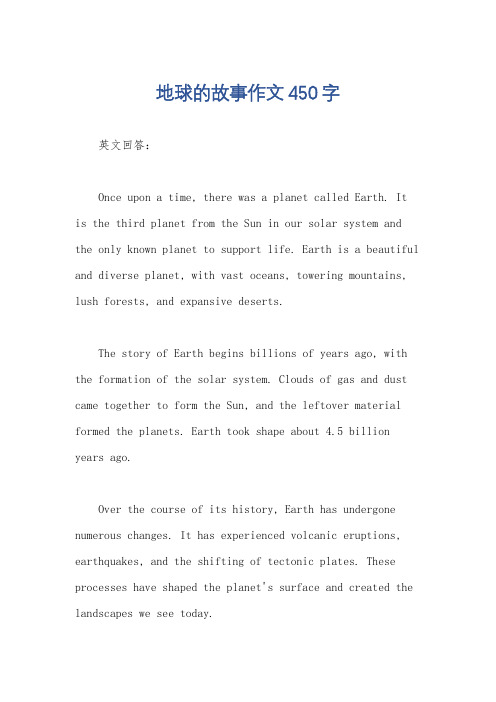
地球的故事作文450字英文回答:Once upon a time, there was a planet called Earth. It is the third planet from the Sun in our solar system and the only known planet to support life. Earth is a beautiful and diverse planet, with vast oceans, towering mountains, lush forests, and expansive deserts.The story of Earth begins billions of years ago, with the formation of the solar system. Clouds of gas and dust came together to form the Sun, and the leftover material formed the planets. Earth took shape about 4.5 billion years ago.Over the course of its history, Earth has undergone numerous changes. It has experienced volcanic eruptions, earthquakes, and the shifting of tectonic plates. These processes have shaped the planet's surface and created the landscapes we see today.Earth is also home to a wide variety of life forms. From tiny microorganisms to massive whales, the planet is teeming with biodiversity. Plants, animals, and humans all coexist on this remarkable planet.Humans, in particular, have had a significant impact on Earth. Through our actions, we have altered the environment and caused pollution. Deforestation, climate change, and the depletion of natural resources are just a few of the challenges we face today.Despite these challenges, Earth remains a resilient and awe-inspiring planet. It is our responsibility to protect and preserve its beauty for future generations.中文回答:从前,有一个叫做地球的星球。
关于外星人故事的英语作文
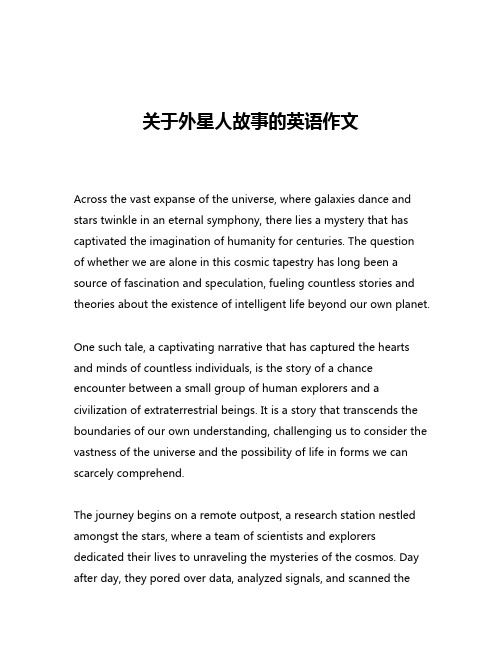
关于外星人故事的英语作文Across the vast expanse of the universe, where galaxies dance and stars twinkle in an eternal symphony, there lies a mystery that has captivated the imagination of humanity for centuries. The questionof whether we are alone in this cosmic tapestry has long been a source of fascination and speculation, fueling countless stories and theories about the existence of intelligent life beyond our own planet.One such tale, a captivating narrative that has captured the hearts and minds of countless individuals, is the story of a chance encounter between a small group of human explorers and a civilization of extraterrestrial beings. It is a story that transcends the boundaries of our own understanding, challenging us to consider the vastness of the universe and the possibility of life in forms we can scarcely comprehend.The journey begins on a remote outpost, a research station nestled amongst the stars, where a team of scientists and explorers dedicated their lives to unraveling the mysteries of the cosmos. Day after day, they pored over data, analyzed signals, and scanned theheavens, searching for any sign of intelligent life beyond the confines of Earth.One fateful night, as the crew slumbered, a series of anomalies began to manifest on the station's sensors. Alarms blared, and the team sprang into action, their hearts racing with a mixture of excitement and trepidation. What they discovered in the depths of space would forever change the course of human history.Emerging from the darkness, a massive craft, its sleek and otherworldly design unlike anything they had ever seen, slowly materialized before their awestruck eyes. The crew held their breath, their fingers dancing across the controls as they attempted to make contact, to establish a line of communication with these mysterious visitors.After what felt like an eternity, a response came, a series of signals and data transmissions that defied their understanding of language and technology. Undeterred, the team worked tirelessly, deciphering the alien code, piece by piece, until finally, a connection was made.The exchange that followed was nothing short of extraordinary. The extraterrestrial beings, a civilization far more advanced than our own, revealed themselves to be a peaceful and curious species, driven by a thirst for knowledge and a desire to explore the vastness of thecosmos. They spoke of wonders beyond our wildest imaginings, of technologies that could reshape the very fabric of our existence, and of a cosmic community teeming with life and diversity.As the days turned into weeks, the bond between the human explorers and their alien counterparts deepened. They shared knowledge, ideas, and perspectives, each side marveling at the richness and complexity of the other's culture and way of life. The crew, once cautious and uncertain, found themselves captivated by the alien civilization, drawn in by their profound wisdom and their unwavering commitment to the pursuit of understanding.But with this newfound connection came a sobering realization – the human race was not alone in the universe, and the implications of this discovery were staggering. The team grappled with the ethical and philosophical questions that arose, debating the ramifications of this momentous encounter and its potential impact on the future of humanity.Would the revelation of extraterrestrial life forever alter the course of human civilization? Would it usher in a new era of cooperation and understanding, or would it lead to conflict and division? These were the questions that weighed heavily on the minds of the explorers as they navigated this uncharted territory.As the dialogue between the humans and their alien counterparts deepened, the team began to uncover startling truths about the nature of the universe and the interconnectedness of all life. They learned of ancient civilizations that had risen and fallen, of cosmic cycles that spanned millennia, and of a grand tapestry of existence that transcended the boundaries of any single planet or species.The more they learned, the more their own perspectives shifted. They began to see the world through new eyes, to recognize the fragility and the resilience of life, and to understand the profound responsibility that came with being part of a greater cosmic community.And so, as the days turned into months, the explorers found themselves transformed, their once-familiar worldviews shattered and rebuilt, their sense of purpose and place in the universe forever altered. They knew that the knowledge they had gained, the connections they had forged, would forever change the course of human history, a legacy that would echo through the ages.In the end, the story of the human explorers and their alien counterparts is not just a tale of discovery and wonder, but a testament to the power of curiosity, the beauty of diversity, and the transformative potential of understanding. It is a reminder that the universe is a vast and wondrous place, teeming with possibilities andmysteries that we have only begun to unravel.And as we gaze out into the endless expanse of the cosmos, we can't help but wonder – what other stories, what other civilizations, await us in the depths of the unknown? The journey has only just begun.。
人类从哪里来的英语作文
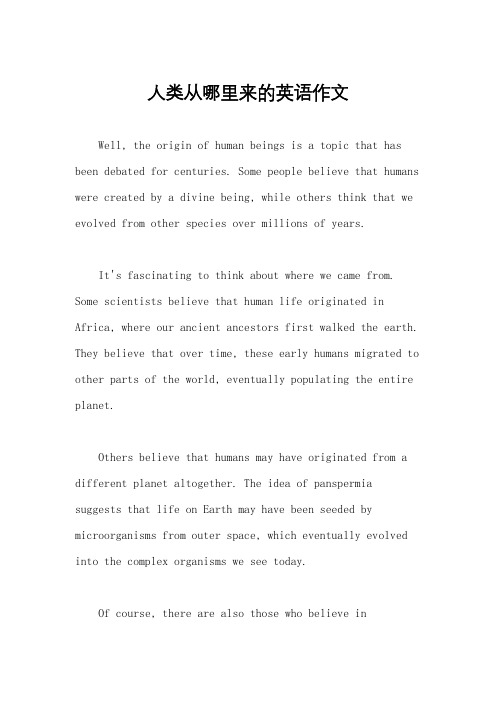
人类从哪里来的英语作文Well, the origin of human beings is a topic that has been debated for centuries. Some people believe that humans were created by a divine being, while others think that we evolved from other species over millions of years.It's fascinating to think about where we came from. Some scientists believe that human life originated in Africa, where our ancient ancestors first walked the earth. They believe that over time, these early humans migrated to other parts of the world, eventually populating the entire planet.Others believe that humans may have originated from a different planet altogether. The idea of panspermia suggests that life on Earth may have been seeded by microorganisms from outer space, which eventually evolved into the complex organisms we see today.Of course, there are also those who believe increationism, the idea that humans were created by a higher power. According to this belief, humans were created in the image of a divine being, and our existence is part of a larger, purposeful plan.Regardless of where we came from, one thing is for sure: humans have a deep-seated curiosity about our origins. Whether we believe in evolution, creationism, or something else entirely, the question of where we came from will continue to captivate and inspire us for generations to come.。
人类到宇宙的科幻作文英语
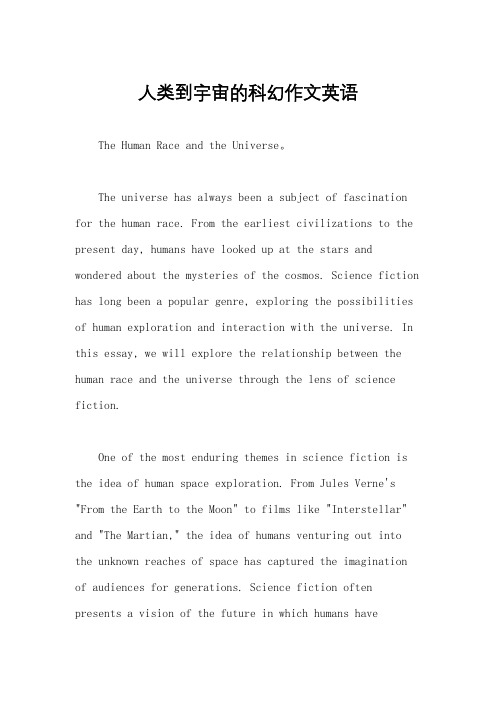
人类到宇宙的科幻作文英语The Human Race and the Universe。
The universe has always been a subject of fascination for the human race. From the earliest civilizations to the present day, humans have looked up at the stars and wondered about the mysteries of the cosmos. Science fiction has long been a popular genre, exploring the possibilities of human exploration and interaction with the universe. In this essay, we will explore the relationship between the human race and the universe through the lens of science fiction.One of the most enduring themes in science fiction is the idea of human space exploration. From Jules Verne's "From the Earth to the Moon" to films like "Interstellar" and "The Martian," the idea of humans venturing out into the unknown reaches of space has captured the imagination of audiences for generations. Science fiction often presents a vision of the future in which humans haveestablished colonies on other planets, or even travel between star systems. This vision of the future is both exciting and daunting, as it raises questions about the potential for human expansion beyond our own planet.Another common theme in science fiction is the idea of alien life. Countless stories and films have explored the possibility of humans encountering extraterrestrial beings, and the implications of such a discovery. While the existence of alien life remains a mystery, science fiction allows us to imagine what it might be like to make contact with beings from another world. This exploration of the unknown is a central theme in science fiction, reflecting humanity's desire to understand the universe and our place within it.In addition to space exploration and alien life, science fiction often delves into the nature of the universe itself. Concepts such as time travel, parallel universes, and the multiverse are common themes in the genre, challenging our understanding of the laws of physics and the nature of reality. These ideas push the boundariesof human knowledge and imagination, offering new perspectives on the universe and our place within it.In many ways, science fiction serves as a reflection of our own curiosity and ambition. The human race has always been driven by a desire to explore and understand the world around us, and the universe is the ultimate frontier. Science fiction allows us to explore the possibilities of what lies beyond our own planet, and to consider the implications of our potential interactions with the wider cosmos.Of course, science fiction is just that – fiction. While it offers a window into the possibilities of the future, it is important to remember that the universe remains a vast and largely unexplored expanse. The challenges of space travel, the search for extraterrestrial life, and the nature of the universe itself are complex and daunting. However, the human race has never been one to shy away from a challenge, and our curiosity about the universe will continue to drive us forward.In conclusion, the relationship between the human race and the universe is a complex and multifaceted one, and science fiction offers a unique lens through which to explore this relationship. Whether it is through the exploration of space, the search for alien life, or the contemplation of the nature of the universe itself, science fiction allows us to imagine the possibilities of what lies beyond our own planet. As we continue to push the boundaries of human knowledge and exploration, the universe will remain a source of fascination and inspiration for generations to come.。
快乐读书吧人类起源的演化过程故事梗概
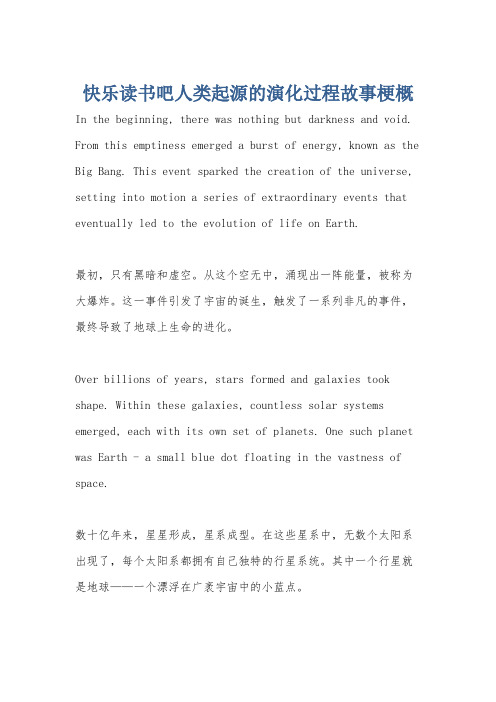
快乐读书吧人类起源的演化过程故事梗概In the beginning, there was nothing but darkness and void. From this emptiness emerged a burst of energy, known as the Big Bang. This event sparked the creation of the universe, setting into motion a series of extraordinary events that eventually led to the evolution of life on Earth.最初,只有黑暗和虚空。
从这个空无中,涌现出一阵能量,被称为大爆炸。
这一事件引发了宇宙的诞生,触发了一系列非凡的事件,最终导致了地球上生命的进化。
Over billions of years, stars formed and galaxies took shape. Within these galaxies, countless solar systems emerged, each with its own set of planets. One such planet was Earth - a small blue dot floating in the vastness of space.数十亿年来,星星形成,星系成型。
在这些星系中,无数个太阳系出现了,每个太阳系都拥有自己独特的行星系统。
其中一个行星就是地球——一个漂浮在广袤宇宙中的小蓝点。
On this young planet, conditions were just right for life to emerge. The oceans formed, providing a nurturing environment for simple organisms to thrive. These earlylife forms were microscopic in nature and lacked complex structures.在这颗年轻的行星上,条件对生命的诞生非常适合。
重返地球科幻故事作文英文

重返地球科幻故事作文英文英文:As I stepped out of the spaceship and onto the familiar soil of Earth, I couldn't help but feel a sense ofnostalgia and wonder. It had been so long since I had last set foot on this planet, and yet everything seemed so familiar and yet so different at the same time.I remember the first time I left Earth to embark on my intergalactic journey. It was a mix of excitement and trepidation, not knowing what lay ahead in the vast expanse of space. But now, as I looked up at the familiar blue sky and felt the gentle breeze on my skin, I couldn't help but feel a sense of relief and comfort.Walking through the bustling streets of the city, I marveled at how much had changed since I had last been here. The technology had advanced by leaps and bounds, and the people seemed to be in such a hurry, always rushing fromone place to another. It was a stark contrast to the serene and peaceful existence I had experienced in the far reaches of the galaxy.But amidst all the hustle and bustle, I couldn't help but notice the little things that hadn't changed. The smell of freshly baked bread from the corner bakery, the sound of children laughing and playing in the park, and the warmth of a friendly smile from a stranger. These were the things that made Earth feel like home, no matter how much time had passed.As I reunited with old friends and family, I found myself reminiscing about the adventures and experiences I had in outer space. I shared stories of alien encounters, breathtaking landscapes on distant planets, and the thrill of space travel. But no matter how incredible those experiences were, there was something about being back on Earth that filled me with a sense of belonging and contentment.中文:当我走出宇宙飞船,踏上熟悉的地球土壤时,我禁不住感到一种怀旧和惊奇。
来自宇宙的我英语作文初中

来自宇宙的我英语作文初中As someone from outer space, I have always been fascinated by the planet Earth. From the vast oceans to the towering mountains, there is so much to explore and discover on this beautiful planet.When I first arrived on Earth, I was struck by the incredible diversity of life that exists here. From the tiniest insects to the largest mammals, there are so many different species that call this planet home. I was particularly fascinated by the humans, who are capable of such incredible feats of creativity and innovation.Over time, I have come to appreciate the many different cultures and traditions that exist on Earth. Each one is unique and special in its own way, and I have enjoyed learning about them all. From the ancient civilizations of Egypt and China to the modern-day cultures of Europe and North America, there is so much to discover and explore.Of course, there are also many challenges that come with living on Earth. Pollution, climate change, and other environmental issues are all major concerns that must be addressed if we are to ensure the long-term health andwell-being of the planet. But I am optimistic that with the right efforts and dedication, we can overcome these challenges and create a better future for all.As someone from outer space, I feel a deep sense of responsibility to help protect and preserve the planet Earth. Whether it's through supporting environmental initiatives, promoting peace and understanding between different cultures, or simply living a sustainable and responsible lifestyle, there are many ways that we can all make a positive impact on the world around us.In the end, I am grateful for the opportunity to experience life on Earth and to be a part of thisincredible planet. I look forward to continuing to explore and discover all that it has to offer, and to working together with others to create a brighter future for all.。
地球与外星人的故事作文500字
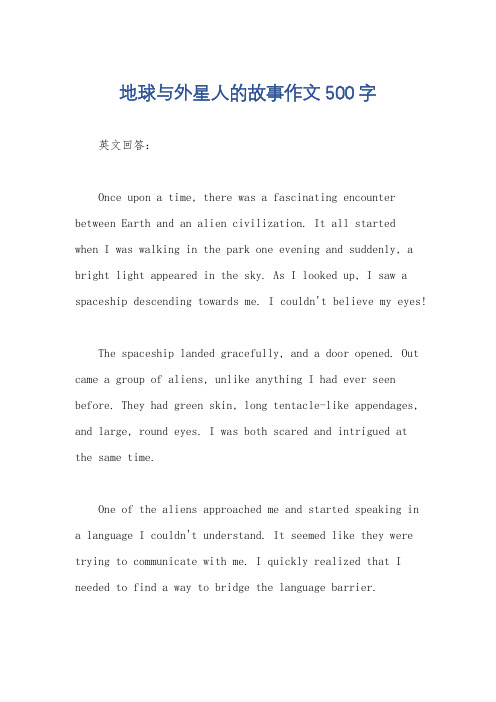
地球与外星人的故事作文500字英文回答:Once upon a time, there was a fascinating encounter between Earth and an alien civilization. It all started when I was walking in the park one evening and suddenly, a bright light appeared in the sky. As I looked up, I saw a spaceship descending towards me. I couldn't believe my eyes!The spaceship landed gracefully, and a door opened. Out came a group of aliens, unlike anything I had ever seen before. They had green skin, long tentacle-like appendages, and large, round eyes. I was both scared and intrigued atthe same time.One of the aliens approached me and started speaking in a language I couldn't understand. It seemed like they were trying to communicate with me. I quickly realized that I needed to find a way to bridge the language barrier.I took out my phone and used a translation app to communicate with the alien. We started off with simple greetings and introductions. The alien introduced itself as Zog and explained that they had come from a distant planet called Xeno.As we continued our conversation, I learned that the aliens were on a mission to explore different planets and learn about different civilizations. They were fascinated by Earth and wanted to know more about our culture, technology, and way of life.I took Zog on a tour of the city, showing them famous landmarks, local cuisine, and even introducing them to some of my friends. Zog was amazed by the diversity of our planet and how we coexist with different cultures and beliefs.During our time together, Zog taught me some phrases in their native language. It was a fun and interactive way to learn about their culture. We exchanged stories and shared our experiences, finding common ground despite ourdifferences.As our friendship grew, Zog invited me to visit their planet, Xeno. I couldn't pass up such an incredible opportunity. I packed my bags and boarded their spaceship, ready for a new adventure.中文回答:从前,地球和外星文明之间发生了一次令人着迷的相遇。
地球的故事创意作文开头

地球的故事创意作文开头英文回答:In the boundless tapestry of the cosmos, amidst the shimmering celestial bodies, lies a planet of unparalleled beauty and wonder: Earth. From its swirling oceans to its towering mountains and vibrant ecosystems, Earth'sintricate story captivates the imagination and inspires countless tales.In the beginning, Earth was a molten sphere of fire and ash. As it cooled, its heavy elements sank to its core, forming the planet's dense mantle and inner core. Lighter elements rose to the surface, creating a primordial atmosphere and the first oceans.Over eons, Earth's atmosphere evolved through constant interaction with its geology and oceans. Volcanic eruptions released gases that enriched the atmosphere with essential elements, while the oceans absorbed carbon dioxide,regulating the planet's temperature.Life emerged on Earth approximately 3.5 billion years ago, transforming the planet into a vibrant biosphere. Single-celled organisms evolved into complex multicellular creatures, diversifying into a dazzling array of species. The Earth's ecosystems became interconnected webs of interdependence, each playing a vital role in maintaining the planet's delicate balance.Humankind, a relatively recent arrival on the planet, has had a profound impact on Earth's history. Our technological advancements have allowed us to manipulate the environment, unlock its resources, and transcend the boundaries of our home planet. However, our actions also carry significant consequences, threatening the delicate equilibrium that has sustained life on Earth for billions of years.As we delve into the story of Earth, we will exploreits origins, its evolution, and its current challenges. We will witness the interplay between geology, atmosphere, andlife, and trace the impact of human activity on theplanet's ecosystems. Along the way, we will encounter extraordinary creatures, discover hidden worlds, and gain a newfound appreciation for the interconnectedness of all living things.中文回答:在浩瀚的宇宙中,闪耀的天体环绕着,一颗星球以其无与伦比的美丽和壮观而存在,地球。
初中英语外星人的故事

初中英语外星人的故事Title: The Alien from Outer SpaceOnce upon a time, a small planet named Erth was quietly orbiting the sun. Erth was populated by a friendly and curious species called the humans. They lived in peace and harmony, exploring their world and learning from each other. Then one day, something extraordinary happened.A spaceship from a distant planet, called Zorak, appeared in Erth's sky. The Zorakians were a highly advanced civilization, with technology far beyond anything the humans had ever seen. They were tall, with green skin and large oval-shaped heads. The humans were fascinated by these alien visitors and eagerly welcomed them to their planet.The Zorakians were on a mission to find new life forms and explore the universe. They were kind and eager to learn about Erth's unique culture and ways. The humans, in turn, were eager to share their knowledge and experiences. The two species quickly became friends.The Zorakians had a special device that could turn any object into any other object. One day, while playing with the device, a young human named Tommy accidentally turned his dog, Buddy, into a pink elephant. Buddy, now with the body of anelephant and the mind of a dog, was a sight to behold! Everyone laughed and had fun with Buddy's newfound "talents."But soon, the Zorakians' visit came to an end. They had to return to their home planet, leaving the humans with a newfound understanding of the vast universe beyond their own world. The humans bid farewell to their alien friends, promising to always remember their shared adventures.And so, the aliens from outer space left Erth and returned to the stars. The humans, now with a new perspective on life and the universe, continued to explore their own world with renewed curiosity and wonder. And Buddy the pink elephant? He lived a happy life with his human family, still bounding around and bringing smiles to everyone he met.The End以上是一个简单的初中英语外星人故事,这个故事讲述了人类和外星人之间的友谊和探索。
人类来到宇宙中的英语作文

人类来到宇宙中的英语作文1. The moment we stepped into the vastness of space, everything changed. The stars seemed closer, the darkness more comforting. It was like stepping into a dream, where reality and imagination blurred together in a beautiful dance.2. In the silence of the cosmos, we found a new kind of peace. The chaos of Earth faded away, replaced by a sense of awe and wonder at the infinite possibilities that lay before us. It was a humbling experience, to realize just how small we really are in the grand scheme of things.3. As we looked back at our home planet from afar, a sense of nostalgia washed over us. The familiar sights and sounds of Earth seemed so distant now, like memories of a past life. But at the same time, we felt a deep connection to our roots, a reminder of where we came from and what we left behind.4. Exploring the unknown corners of the universe, we encountered wonders beyond our wildest dreams. Alien landscapes, strange creatures, and technologies far beyond our understanding. It was both exhilarating and terrifying, to be so far from home yet so alive with the thrill of discovery.5. And yet, amidst all the excitement and adventure, there was a sense of longing for the familiar comforts of Earth. The taste of home-cooked meals, the sound of laughter with friends, the feeling of solid ground beneath our feet. Space was a beautiful and mysterious place, butit could never replace the warmth and love of our home planet.6. So we journeyed on, carrying with us the memories of our past and the dreams of our future. We were pioneers, explorers, adventurers in a vast and infinite universe. And as we gazed out into the unknown, we knew that no matter where we went, Earth would always be our true home.。
人类与宇宙的对话作文英语
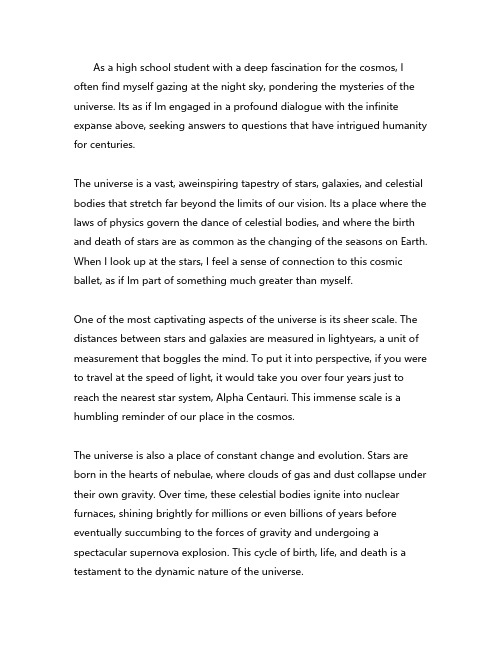
As a high school student with a deep fascination for the cosmos, I often find myself gazing at the night sky, pondering the mysteries of the universe. Its as if Im engaged in a profound dialogue with the infinite expanse above, seeking answers to questions that have intrigued humanity for centuries.The universe is a vast, aweinspiring tapestry of stars, galaxies, and celestial bodies that stretch far beyond the limits of our vision. Its a place where the laws of physics govern the dance of celestial bodies, and where the birth and death of stars are as common as the changing of the seasons on Earth. When I look up at the stars, I feel a sense of connection to this cosmic ballet, as if Im part of something much greater than myself.One of the most captivating aspects of the universe is its sheer scale. The distances between stars and galaxies are measured in lightyears, a unit of measurement that boggles the mind. To put it into perspective, if you were to travel at the speed of light, it would take you over four years just to reach the nearest star system, Alpha Centauri. This immense scale is a humbling reminder of our place in the cosmos.The universe is also a place of constant change and evolution. Stars are born in the hearts of nebulae, where clouds of gas and dust collapse under their own gravity. Over time, these celestial bodies ignite into nuclear furnaces, shining brightly for millions or even billions of years before eventually succumbing to the forces of gravity and undergoing a spectacular supernova explosion. This cycle of birth, life, and death is a testament to the dynamic nature of the universe.As I contemplate the universe, I cant help but wonder about the possibility of extraterrestrial life. With billions of galaxies, each containing billions of stars, the odds of life existing elsewhere in the cosmos seem tantalizingly high. The discovery of exoplanets, planets orbiting stars outside our solar system, has only fueled this curiosity. Some of these exoplanets exist in the habitable zones of their stars, where conditions might be just right for life as we know it to flourish.The search for extraterrestrial life also raises philosophical questions about our existence. If we are not alone in the universe, what does that mean for our place in the cosmic scheme of things? Are we unique, or are we just one of many intelligent species? These questions challenge our understanding of life, consciousness, and our purpose in the universe.One of the most profound aspects of the universe is its age. The universe is approximately 13.8 billion years old, as determined by observations of the cosmic microwave background radiation. This ancient timeline is difficult to comprehend, as it encompasses the entire history of the cosmos, from the Big Bang to the present day. Its a reminder of the fleeting nature of our own existence in comparison to the grand timeline of the universe.As I continue my dialogue with the universe, I am struck by the beauty and complexity of the cosmos. The intricate patterns of spiral galaxies, the ethereal glow of nebulae, and the majestic dance of binary star systems all serve as a testament to the wonder and beauty of the universe. Thesecelestial sights inspire a sense of awe and reverence, as well as a desire to learn more about the cosmos and our place within it.In conclusion, the universe is a vast and mysterious realm that invites us to engage in a dialogue of discovery and wonder. It challenges our understanding of the cosmos and our place within it, while also inspiring us with its beauty and complexity. As a high school student, I am excited to continue exploring the universe, asking questions, and seeking answers that will deepen my understanding of this incredible cosmic dialogue.。
跟探索宇宙有关的英语经典小故事
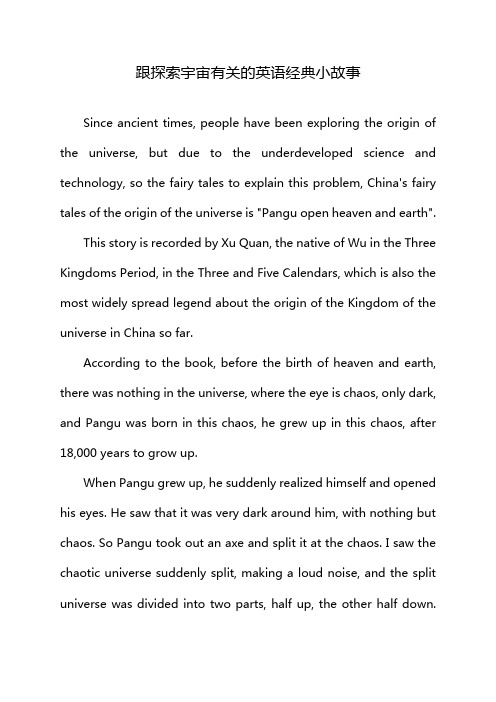
跟探索宇宙有关的英语经典小故事Since ancient times, people have been exploring the origin of the universe, but due to the underdeveloped science and technology, so the fairy tales to explain this problem, China's fairy tales of the origin of the universe is "Pangu open heaven and earth".This story is recorded by Xu Quan, the native of Wu in the Three Kingdoms Period, in the Three and Five Calendars, which is also the most widely spread legend about the origin of the Kingdom of the universe in China so far.According to the book, before the birth of heaven and earth, there was nothing in the universe, where the eye is chaos, only dark, and Pangu was born in this chaos, he grew up in this chaos, after 18,000 years to grow up.When Pangu grew up, he suddenly realized himself and opened his eyes. He saw that it was very dark around him, with nothing but chaos. So Pangu took out an axe and split it at the chaos. I saw the chaotic universe suddenly split, making a loud noise, and the split universe was divided into two parts, half up, the other half down.The rising half became the sky, and the sinking half became the ground, and for a while, the light hung over the whole universe, Pangu feared that they were joined again, and stood in the middle, holding his hands in the sky and his feet on the ground, never moving half a step again.With the passage of time, the sky began to rise, a day can rise a zhang, and the ground also began to become thick, a day thick a zhang, with the distance between heaven and earth widened, the height of Pangu also changed, in this way, Pangu supported 18,000 years, until heaven and earth no longer closed.But at this time, Pangu has also been overworked, he and then fell to the ground and died, but his body has also turned into time and everything. The breath of his breath, some into the air, into the clouds in the sky, some shouted, into a gust of wind, he fell when the low hum, into loud thunder.His left eye turned into the sun, his right eye into the moon, drifting to the sky, while his hands and feet were winding along the earth, into high mountains, blood flowing into rivers, veins into roads, hair and beard into stars in the sky.Every tree and grass is his hair, stones and pearls are his teeth and bones, even the sweat on the body, also turned into rain and dew.。
人类移居外太空演讲稿的英语作文

人类移居外太空演讲稿的英语作文Ladies and gentlemen,I stand here today to talk about a topic that may seem like science fiction to some, but is becoming more and more of a reality with each passing day – human colonization of outer space. The idea of humans living beyond Earth may soundfar-fetched, but with advancements in technology and the increasing challenges faced on our own planet, the idea is slowly becoming a necessity.As we look at the issues facing our world today – climate change, overpopulation, resource depletion – it becomes clear that we need to start looking beyond Earth for solutions. The resources available in space are nearly limitless, from minerals on asteroids to vast amounts of energy from the sun. By moving some of our population and industry off of Earth, we can alleviate some of the strain on our planet and ensure a sustainable future for generations to come.But beyond the practical benefits, the idea of humans living in space also opens up a whole new realm of possibilities. Imagine a world where humans are no longer confined to a single planet, where we can explore new worlds and push theboundaries of what we thought was possible. The exploration of space has always been a dream of mankind, and now we have the opportunity to make that dream a reality.Of course, the challenges of living in space are immense. We must develop new technologies to ensure our survival in the harsh environment of outer space, from radiation shielding to growing food in microgravity. But these challenges are not insurmountable, and with the right resources and dedication, we can make human colonization of space a reality.In conclusion, the time has come for humans to start looking beyond Earth and towards the stars. By colonizing outer space, we can ensure the survival of our species and continue the exploration that has always driven us forward. The future of humanity lies in space, and it is up to us to take the first steps towards that future.Thank you.。
- 1、下载文档前请自行甄别文档内容的完整性,平台不提供额外的编辑、内容补充、找答案等附加服务。
- 2、"仅部分预览"的文档,不可在线预览部分如存在完整性等问题,可反馈申请退款(可完整预览的文档不适用该条件!)。
- 3、如文档侵犯您的权益,请联系客服反馈,我们会尽快为您处理(人工客服工作时间:9:00-18:30)。
The birth of nebulae and stars
Gravity and form particle swarm on each particle, which attract more particles, gas ball under appropriate conditions, in the center of the hot, dense enough, can generate burning helium and hydrogen producing stars. Born in the right as the stars in the Eagle nebula.
The formation and early history of the earth
4.6 billion years ago, the primitive earth, dead frozen world, through three effect to gain energy and began to evolution and development. • 1 ° impact effect: interstellar dust high-speed collision, the kinetic energy to heat energy • 2 ° compression effect: interstellar dust landing on the surface, increase external quality, internal squeezed, compression can be converted into heat energy. • 3 ° radioactive decay effect: radioactive elements in the interior of the earth (uranium, thorium, rubidium, etc.). Release huge energy • Evolution results: composition of the molten iron flows to the center of the earth, the formation of iron core, it is a rocky composition form structures (silicate).
The original star (proto - star) early evolution stage
The formation of the earth
• Origin of the earth is also a variety of theories since the middle of the 18th century. At present more popular view is that around 4.6 billion years ago, from the solar nebula began to differentiate into the original earth, low temperature, light and heavy elements one integrated mass, there is no hierarchical structure. Primitive earth once formed, is conducive to continued accretion the solar nebula material is increasing volume and quality, at the same time due to gravitational differentiation and radioactive elements change with increasing temperature. When the original material in the interior of the earth warming to molten state, than big iron acceleration toward the center of the earth sinking, become a nickel iron core, the proportion of small lithophile elements buoyancy of mantle and crust, lighter liquid and gas composition, overflow surface formed by volcanic eruption original hydrosphere and atmosphere.
Adult stars and nucleosynthesis
Nuclear change function expansion, the star for gravity made the contract, adult stars is the result of this two kinds of balance.
From the universe to the earth
This picture shows the process of planet form born 13.7 billion years ago, It originated as a singularity. In a very short period of time, it has formed most of the material.
supernova
One of the most energetic explosive events known is a supernova. These occur at the end of a star's lifetime, when its nuclear fuel is exhausted and it is no longer supported by the release of nuclear energy. If the star is particularly massive, then its core will collapse and in so doing will release a huge amount of energy. This will cause a blast wave that ejects the star's envelope into interstellar space. The result of the collapse may be, in some cases, a rapidly rotating neutron star that can be observed many years later as a radio pulsar. While many supernovae have been seen in nearby galaxies, they are relatively rare events in our own galaxy. The last to be seen was Kepler's star in 1604. This remnant has been studied by many X-ray astronomy satellites, including ROSAT. There are, however, many remnants of Supernovae explosions in our galaxy, that are seen as Xray shell like structures caused by the shock wave propagating out into the interstellar medium. Another famous remnant is the Crab Nebula which exploded in 1054. In this case a pulsar is seen which rotates 30 times a second and emits a rotating beam of X-rays (like a lighthouse). Another dramatic supernova remnant is the Cygnus Loop.
From galaxies to giant molecular cloud
Molecular clouds contain the raw material of stars and planets. A diameter of 300 light-years clouds contain enough for 10000 to 1 million large mass of stars like the sun. Giant molecular cloud before they dissipative sustainable from 10 million to 1 billion.
The impact of the solar system's early frequent events
The impact hypothesis
Now equal to 9/10 the mass of the earth "earth" and the other a mars-sized celestial collision "the moon" Intense collision not only make the "the earth's rotation produces a deflection, and makes" the moon "fracture Fly away from the role of gas and dust material by gravity, the distribution outside the roche limit disk space, they through accretion, have formed a few small objects, and then like a snowball accretion increased continuously, and eventually formed the moon now.
